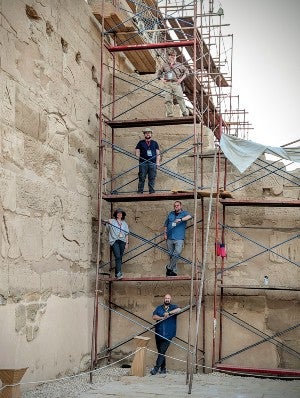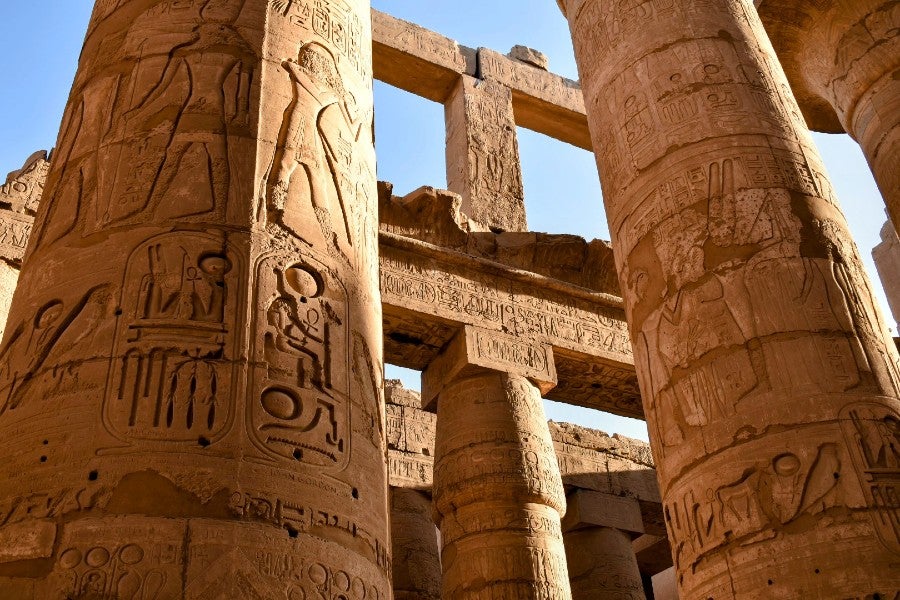Lipscomb’s Archaeology candidates record valuable history in Luxor, Egypt
The Lanier Center for Archaeology sends its second team to digitally record inscriptions and hieroglyphics on Karnak Temple walls.
From Staff Reports |

A Lanier Center for Archaeology team of students and faculty set out for the Karnak Temple Complex in Luxor, Egypt, in May, carrying out the Lanier Center’s second expedition to Egypt since it relocated to Lipscomb five years ago.

Janzen and Baker discuss details of the Hittite Treaty inscribed on the Temple walls.
The five-person team, led by Mark Janzen, associate professor of archaeology and ancient history, carried out the three-week Karnak Great Hypostyle Hall Epigraphic Project in partnership with the University of Memphis, under the direction of UM’s Peter Brand, and with the gracious permission of the Supreme Council of Antiquities.
The project involves detailed review and recording of the preserved scenes and inscriptions on the Karnak temple’s exterior walls and columns of the Cour de la Cachette. Karnak was the start of the processional route leading to the Luxor Temple, the other primary temple on the east bank of the Nile River.
The Cachette Court walls commemorate the military victories of Merneptah, the fourth pharaoh of the Nineteenth Dynasty of Ancient Egypt.
As time and environmental conditions erode the ancient details, teams such as Lanier’s work to preserve the data by transcribing and drawing what is on the walls, creating a permanent, digital record of the monument. The teams worked on 70- and 40-foot columns and Cachette walls, said Janzen, who joined Lanier in 2022 and has worked at Karnak six times now.
That’s just a slice of Karnak, which is essentially the largest Egyptian temple ever built, said Janzen. “You can put the Notre Dame Cathedral in Paris into Karnak four times over,” he said.

The Lanier epigraph team.
And every square inch is covered with some kind of carving. The scenes are of two types: religious scenes and battle scenes, which help scholars understand the military and political history of the region. The state of preservation of the wall has declined even over the past few years, so the work of the team is invaluable for preserving every intricate detail.
“We need to get new photographs made of the whole wall, hopefully with lighting that is a little different from what we already have,” said Janzen. “Also a team of scholars from the Egyptian-French Center for the Study of the Karnak Temples has restored some of the blocks to the wall and they invited our team to study them now that they are back in their original location. That is new primary data that has been laying on the ground in the surrounding area.”
Essentially, their work involves refining the details of the drawings and collating each season’s corrections with a master drawing. Every squiggle and line on the ancient wall, so often overlooked by tourists, is evaluated for its role in a figure or hieroglyph, sometimes preserving only the lightest surviving trace. Sometimes the epigraphers even find a second older image under the surface image, said Janzen.

The epigrapher’s corrections and notes can be seen here in pencil sketches and meticulous descriptions.
Andrew Cahill, Ph.D. student and assistant epigrapher on the project, explains that this season he worked primarily on the two north end battle scenes. The scenes contained in the reliefs relate to the campaigns of Pharaoh Merenptah, and one scene to the south clearly depicts the Egyptian attack of the city of Ashkelon in Canaan, an event recorded on the Merenptah Stele, an inscribed tablet that scholars believe is the earliest textual reference to Israel.
Additionally, the wall includes the famous Hittite Treaty from the reign of Ramesses II, the most complete copy of the oldest peace treaty between large empires in history.
Within the last year, Lanier was given permission to include the treaty in their work, so this year L.S. Baker Jr., Lanier’s research associate and lead epigrapher, focused his diligent efforts on completing a notable amount of work on this wall.
In addition, Terrence J. Nichols, Ph.D. candidate and epigrapher, explored using a laser scanner to create a record of the wall. This preliminary effort is aimed at eventually producing a 3-D model of the treaty back on the Lipscomb campus.
Lanier currently has three students focused on Ancient Egypt, said Janzen. One is expected to earn their Ph.D. by next year, he said.
The team also toured major sites of historical significance in Egypt. This year they visited the Temple of Philae, Medinet Habu, Luxor Temple, Abu Simbel, Deir el-Medina, the Tombs of the Nobles (including the Tomb of Rekhmire), Deir el-Bahari, and the Valleys of Kings and Queens.

The inscribed columns in the Great Hypostyle Hall in the Karnak Temple.